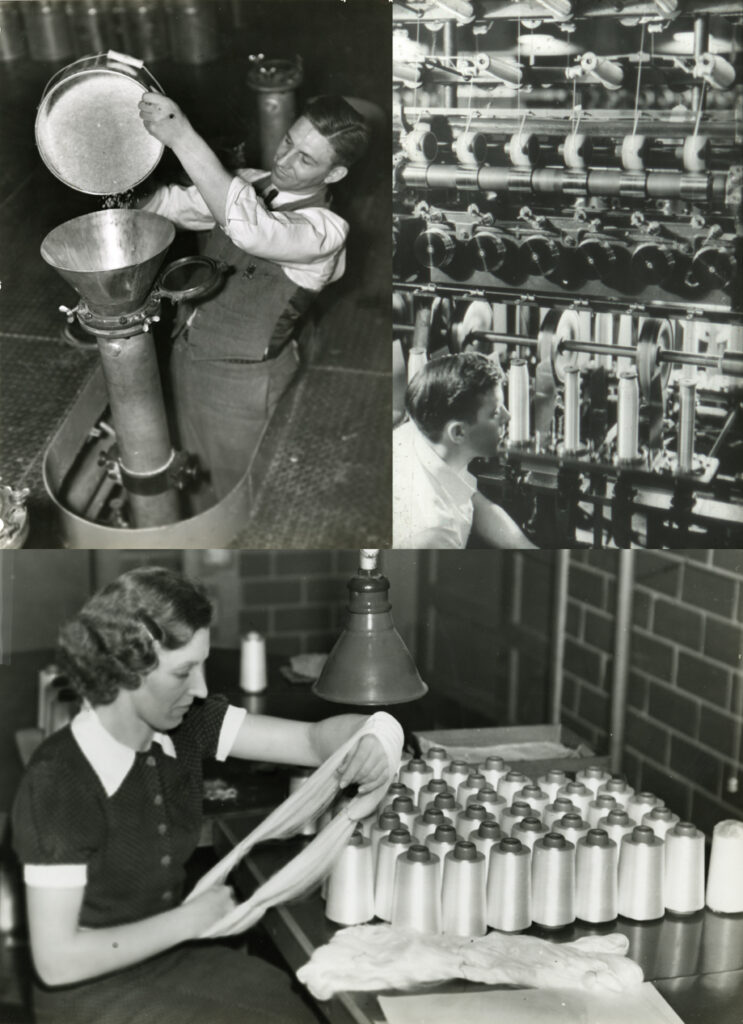On October 27, 1938, 11 years of research involving more than 230 DuPont scientists and technicians culminated in the announcement of the world’s first fully man-made fiber. The company’s publicity arm announced that the fiber was derived from coal, water, and air. It was theory brought to life: an artificial silk spun and drawn from molecular chains of nearly infinite length and molecular weight. Scarcely six months later nylon, as the fiber was now called, took center stage at the 1939 World’s Fair, where DuPont’s Wonder World of Chemistry showcased its latest innovations to an estimated 1.5 million visitors.
In contrast to semisynthetic rayon, which is made from chemically modified plant fibers, such as cotton, nylon boasted both durability and a stable supply of raw materials that chemists could control for quality. The fiber also seemed primed for a vast array of everyday applications, from textiles and bedspreads to twine, fishing nets, and brush bristles. But DuPont fatefully chose hosiery as the vehicle for nylon’s worldwide debut. As models at the Wonder World of Chemistry stretched and twisted stockings to demonstrate the new fiber’s strength and shine, a fashion sensation was born.

A man squats below a yarn-beaming machine at DuPont’s nylon manufacturing plant at Seaford, Delaware, ca. 1940s.
By 1949 expensive silk stockings had fallen out of favor, and hosiery made from nylon and an expanding array of synthetic fibers dominated the market. These synthetics, which later came to include acrylic, polyester, and spandex, gave rise to a mass-market fashion defined by sweater sets and wash-and-wear suits. Yet the staggering success of nylon and its synthetic counterparts obscures the unlikely alliance of the chemical and fashion industries that underwrote the postwar fashion revolution. That alliance paved the way for synthetic materials to replace and even improve on traditional materials, such as silk, cotton, and wool, and ultimately become a natural part of modern life.
DuPont’s Pure Science Division, the birthplace of nylon, was the brainchild of company vice president Charles Stine, who in the late 1920s convinced DuPont’s board to branch out from research with clear profit-making potential and to allocate $250,000 for pure research. Such an approach was not unheard of—both General Electric and Bell Telephone operated research labs—but it was rare, as was the latitude Stine afforded speculative research. He wooed Wallace Carothers and other chemists out of academic posts and into the lab with the offer of ample funding and staffing.
At DuPont, Carothers was free to explore Hermann Staudinger’s controversial theory that polymers consisted of chains of molecules of almost limitless length. After testing a variety of combinations throughout the early 1930s, Carothers and his research team focused on poly-amides—long chains of carbon, oxygen, nitrogen, and hydrogen that could be spun and drawn to produce pliable elastic fibers.

Images from DuPont’s nylon production plant in Wilmington, Delaware, 1938 (clockwise from top left). Mike McCall pours nylon chips into a hopper; the chips will be melted, measured out and filtered before being spun into filament. An unidentified worker oversees the operation of a draw twister, which twists polymer fibers into thread. Violet Grenda inspects skeins of nylon yarn.
In 1936 Carothers’s lab spun polyamides for up to 10 minutes, a critical step toward a viable fiber. As the team continued to develop machinery and equipment to refine the process, DuPont’s marketing group began to explore applications for the new fiber. At the time, Japanese imports accounted for 90% of the United States’ raw silk supply, three-quarters of which was used to manufacture the more than 1.5 million pairs of stockings Americans purchased daily. With Japan’s ongoing industrialization and militarization exacerbating long-standing political tensions, a homegrown substitute for silk fiber looked increasingly attractive.
DuPont began to prototype nylon hose in 1938, part of its effort to sell nylon’s potential to the manufacturers who would ultimately produce the stockings. To that end the company built new machinery and developed stitching techniques specifically for nylon. One such innovation was to stretch newly knitted stockings over leg-shaped forms to prevent shrinkage as stockings were steamed to heat-set their shape and size. These experimental stockings, knitted in February 1939, first debuted at the San Francisco International Exposition and turned heads at the New York World’s Fair later that year. Soon after, fashion magazines and consumer questionnaires documented widespread enthusiasm for the stockings’ sheerness, strength, and smooth, wrinkle-free fit, and nylon quickly became a household name. At the first public sale of nylon stockings on October 24, 1939, in Wilmington, Delaware, the supply of 4,000 pairs sold out in just three hours. Demand only increased after nylon stockings became available nationwide in May 1940. But on February 11, 1942, nylon stockings disappeared from the market as DuPont directed all nylon production to military needs, such as parachutes.
In 1945, after World War II ended, DuPont shifted its focus back to civilian customers, forecasting enough nylon production to knit 360 million pairs of stockings per year. (Technical delays hampered volume production, limiting the number of stockings to reach the market in 1946.) DuPont’s renewed attention to consumer applications led to the creation of a veritable family of fibers, including polyester (1946), acrylic (1955), and spandex (1958), all of which debuted under accessible brand names like Dacron (polyester), Orlon (acrylic), and Lycra (spandex).

A 1969 DuPont promotional photo of designer Louis Féraud’s Qiana jacket. Qiana, a silky nylon material, made up much of the 1970s’ bold disco apparel.
Economic, social, and cultural circumstances drove the rapid adoption and acceptance of nylon and the subsequent embrace of the synthetic fibers that followed. For manufacturers a shortage of traditional raw materials driven by the postwar boom enhanced the appeal of synthetic alternatives derived from abundant gas and oil. For fashion designers the durability, washability, and ease of care of nylon and other man-made fibers opened up creative possibilities that ultimately meant more clothing and accessories for the garment industry to manufacture and sell. And for consumers the unique characteristics of nylon and other synthetics led many to embrace these fibers not just as artificial substitutes for natural substances but as new materials in their own right.
Throughout the 1950s synthetic fabrics helped satisfy the public’s appetite for new clothing options after years of economic depression and war. These materials were turned into socks and petticoats, wedding gowns, dress shirts, and ski pants. Women were the primary market for these clothes, which commonly featured new design details, such as permanent creases, heat-set pleats, wrinkle resistance, and color fastness. These garments brought about a trend of wash-and-wear wardrobes valued for their ease and convenience. Such performance features appealed especially to younger women who, in DuPont research surveys, bemoaned the daily drudgery of ironing and embraced a more carefree, modern lifestyle. It is no coincidence that between 1950 and 1956 washing-machine sales in the United States more than tripled. Such labor-saving qualities further encouraged consumers’ acceptance of synthetic fibers and of chemistry itself, which increasingly provided what nature could not.
Once manufacturers and consumers embraced synthetics, there was no going back. The revolution that began with nylon gave rise to new silhouettes, textures, and colors impossible to create with natural fibers and continued to shape consumer tastes in the decades to come.




